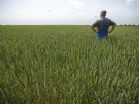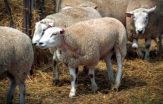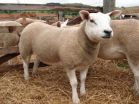(Press-News.org) HOUSTON – (June 6, 2014) -- An international team of scientists including the Human Genome Sequencing Center at Baylor College of Medicine has completed the first ever sequence of the sheep genome, shedding new information on the species' unique and specialized digestive and metabolic systems.
Sheep, a major source of meat, milk, and fiber in the form of wool, are important to the agriculture industry. This exploration of sheep genetic characteristics found features that comprise their specialized digestive systems including the rumen (the first chamber of their stomach which helps digests plant material to animal protein) and fatty acid metabolism.
The collaboration, which included 73 authors from 26 institutions across eight countries, published the work today in the journal Science.
The team identified highly expressed genes encoding proteins that may cross-link keratins (structural proteins of hair, nails, horn, hoofs, wool and feathers – the outermost layers of the skin) at the rumen surface.
Additionally, they identified changes in genes involved in lipid metabolism (fatty acids such as natural oils, waxes and steroids) and their role in wool synthesis.
The sequencing efforts of the project were conducted at the Human Genome Sequencing Center with Dr. Kim Worley, professor in the Center, as the lead investigator of the Baylor portion of the study. Worley also serves as a co-author on the report.
INFORMATION:
For more information or to interview Dr. Worley, please contact Glenna Picton at 713-798-4710 or picton@bcm.edu.
The collaboration included: Australia (Commonwealth Scientific and Industrial Research Organisation; University of New England; University of Sydney); China (BGI-Shenzhen; Inner Mongolia Agricultural University; Institute of ATCG, Nei Mongol Bio-Information; Kunming Institute of Zoology; Lanzhou Institute of Husbandry and Pharmaceutical Science; Macau University of Science and Technology; North West A&F University; Sichuan Agricultural University), Denmark (University of Copenhagen); France (INRA); New Zealand (AgResearch; University of Otago); Saudi Arabia (King Abdulaziz University); The United Kingdom (Biosciences KTN; Edinburgh Genomics; European Molecular Biology Laboratory, European Bioinformatics Institute; The Roslin Institute; Wellcome Trust Sanger Institute; University of Edinburgh) and the United States (Human Genome Sequencing Center at Baylor; United States Department of Agriculture's Agriculture Research Service Animal Disease Research Unit; Utah State University and Washington State University).
International collaboration explains sheep genome, secrets of unique digestive and metabolic systems
2014-06-05
ELSE PRESS RELEASES FROM THIS DATE:
Amunix presents XTEN half-life extension technology at Next Generation Protein Therapeutics Summit
2014-06-05
Mountain View, CA – June 5, 2014 – Amunix Operating Inc. said today it is presenting unpublished data from its XTEN half-life extension technology development programs during two sessions this week at IBC's 9th Annual Next Generation Protein Therapeutics Summit in San Francisco, CA. Amunix is a biotechnology company developing hydrophilic, unstructured polypeptides which can be recombinantly fused or chemically conjugated to other peptides, proteins and small molecules.
Vladimir N. Podust, PhD, Director of Analytical Chemistry, Amunix Operating Inc., will present "Extension ...
New EU reforms fail European wildlife
2014-06-05
Despite political proclamation of increased environmental focus, experts argue that the European Union's recent agricultural reforms are far too weak to have any positive impact on the continent's shrinking farmland biodiversity, and call on member states to take action.
About half of all farmland and at least 88% of EU farmers are exempt from Ecological Focus Areas, the main "greening measure" that could help wildlife on farmland.
Meeting EU's own biodiversity targets for 2020 now relies on initiatives from member states.
Experts from leading organisations offer ...
What's in the sheep genome? Wool see
2014-06-05
After eight years of work, researchers have completed the first sequencing of the entire sheep genome.
Scientists from CSIRO led an international research team to complete the sequencing, which could lead to more effective breeding strategies and new approaches to the management of sheep in Australia and around the world.
With about 70m head of sheep in Australia and 1bn globally, the sequencing of the genome could have a massive impact for the rural economy given that sheep are a major source of meat, milk and wool products.
"We investigated the completed genome to ...
Sleep after learning strengthens connections between brain cells and enhances memory
2014-06-05
June 5, 2014 -- In study published today in Science, researchers at NYU Langone Medical Center show for the first time that sleep after learning encourages the growth of dendritic spines, the tiny protrusions from brain cells that connect to other brain cells and facilitate the passage of information across synapses, the junctions at which brain cells meet. Moreover, the activity of brain cells during deep sleep, or slow-wave sleep, after learning is critical for such growth.
The findings, in mice, provide important physical evidence in support of the hypothesis that ...
Scientists crack sheep genome, shining spotlight on rumen evolution and lipid metabolism
2014-06-05
Shenzhen, June 5, 2014--- The latest study, led by scientists from Kunming Institute of Zoology, Chinese Academy of Sciences, BGI and other institutes, presents a high-quality sheep genome and reveals genomic and transcriptomic events that may be associated with rumen evolution and lipid metabolism that have relevance to both diet and wool. The work was published online today in Science.
Sheep are ruminants with a complex, 4-compartmented "stomach", the largest compartment is the rumen, which is thought to have evolved around 35-40 million years ago, and has the ability ...
Gene study shows how sheep first separated from goats
2014-06-05
Scientists have cracked the genetic code of sheep to reveal how they became a distinct species from goats around four million years ago.
The study is the first to pinpoint the genetic differences that make sheep different from other animals.
The findings could aid the development of DNA testing to speed-up selective breeding programmes, helping farmers to improve their stocks.
The research identifies the genes that give sheep their fleece and uncovers features of their digestive system, which makes them so well-suited to a diet of low quality grass and other plants.
It ...
Brain circuit problem likely sets stage for the 'voices' that are symptom of schizophrenia
2014-06-05
(MEMPHIS, Tenn. – June 5, 2014) St. Jude Children's Research Hospital scientists have identified problems in a connection between brain structures that may predispose individuals to hearing the "voices" that are a common symptom of schizophrenia. The work appears in the June 6 issue of the journal Science.
Researchers linked the problem to a gene deletion. This leads to changes in brain chemistry that reduce the flow of information between two brain structures involved in processing auditory information.
The research marks the first time that a specific circuit in the ...
Research could lead to new cancer assay, aid both dogs and humans
2014-06-05
CORVALLIS, Ore. – Veterinary researchers at Oregon State University have identified a unique group of proteins that indicate the presence of transitional cell carcinoma – the most common cause of bladder cancer – and may lead to a new assay which could better diagnose this disease in both dogs and humans.
Bladder cancer is particularly common in some dog breeds, such as collies, sheepdogs and terriers, but is rarely diagnosed in animals before it has spread significantly. Some assays exist to detect it in humans, but they often have a high-number of false-positive identifications.
An ...
New clues to why older women are more vulnerable to breast cancer
2014-06-05
Scientists from the Department of Energy's Lawrence Berkeley National Laboratory (Berkeley Lab) have gained more insights into why older women are more susceptible to breast cancer. They found that as women age, the cells responsible for maintaining healthy breast tissue stop responding to their immediate surroundings, including mechanical cues that should prompt them to suppress nearby tumors.
Their work sheds light on how aging alters cellular and molecular functions, and how these changes contribute to the prevalence of breast cancer in older women. The disease is ...
MAD: Scientists shed light on braking mechanisms in cellular signaling
2014-06-05
Stanford, CA— A team of researchers studying a flowering plant has zeroed in on the way cells manage external signals about prevailing conditions, a capability that is essential for cells to survive in a fluctuating environment.
Researchers at UC Berkeley, the Plant Gene Expression Center, UC San Francisco, and the Carnegie Institution for Science identified a novel mechanism by which the strength of such an external signal is reduced, or attenuated. Their work focuses on the tiny mustard plant Arabidopsis, which is frequently used by scientists as an experimental model. ...



